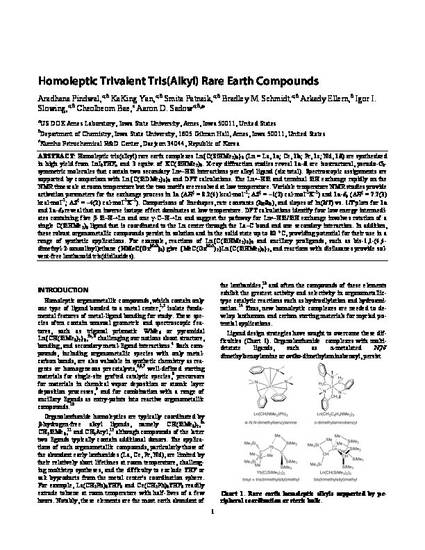
Homoleptic tris(alkyl) rare earth complexes Ln{C(SiHMe2)(3)}(3) (Ln = La, 1a; Ce, 1b; Pr, 1c; Nd, 1d) are synthesized in high yield from LnI(3)THF(n) and 3 equiv of KC(SiHMe2)(3). X-ray diffraction studies reveal 1a-d are isostructural, pseudo-C-3-symmetric molecules that contain two secondary Li <- HSi interactions per alkyl ligand (six total). Spectroscopic assignments are supported by comparison with Ln{C(SiDMe2)(3)}(3) and DFT calculations. The Ln <- HSi and terminal SiH exchange rapidly on the NMR time scale at room temperature, but the two motifs are resolved at low temperature. Variable-temperature NMR studies provide activation parameters for the exchange process in la (Delta H-double dagger = 8.2(4) kcal.mol(-1); Delta S-double dagger = -1(2) cal.mol(-1)K(-1)) and 1a-d(9) (Delta H-double dagger = 7.7(3) kcal.mol(-1); Delta S-double dagger = -4(2) cal.mol(-1)K(-1)). Comparisons of lineshapes, rate constants, (k(H)/k(D)), and slopes of ln (k/T) vs 1/T plots for la and 1a-d(9) reveal that an inverse isotope effect dominates at low temperature. DFT calculations identify four low-energy intermediates containing five beta-Si-H -> Ln and one gamma-C-H -> Ln. The calculations also suggest the pathway for Ln <- HSi/SiH exchange involves rotation of a single C(SiHMe2)(3) ligand that is coordinated to the Ln center through the Ln-C bond and one secondary interaction. These robust organometallic compounds persist in solution and in the solid state up to 80 degrees C, providing potential for their use in a range of synthetic applications. For example, reactions of Ln{C(SiHMe2)(3)}(3) and ancillary proligands, such as bis-1,1-(4,4-dimethyl-2-oxazolinyl)ethane (HMeC(Ox(Me2))(2)) give {MeC(Ox(Me2))(2)}Ln{C(SiHMe2)(3)}(2), and reactions with disilazanes provide solvent-free lanthanoid tris(disilazides).
Available at: http://works.bepress.com/aaron_sadow/63/

This document is the Accepted Manuscript version of a Published Work that appeared in final form in Journal of the American Chemical Society copyright © American Chemical Society after peer review and technical editing by the publisher. To access the final edited and published work see 10.1021/jacs.7b09521. Posted with permission.